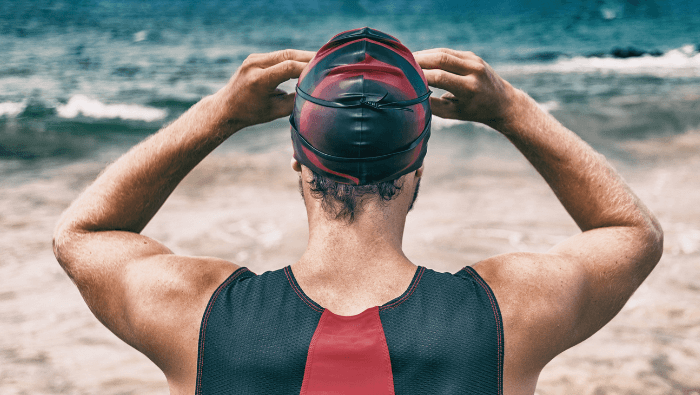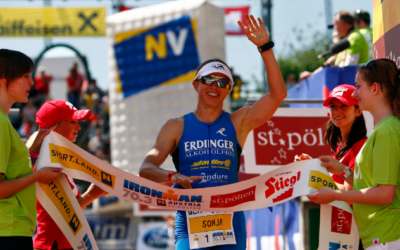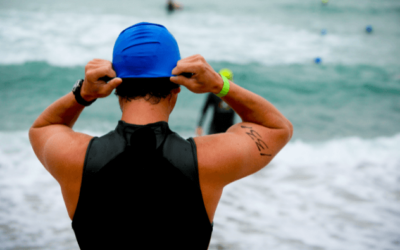Are you a beginner eager to dive into the world of triathlons? If you’re ready to embark on this thrilling challenge, you’re in for an exciting journey.
Triathlon for beginners offers a unique opportunity to push your limits, whether you’re an experienced athlete exploring a new challenge or a fitness enthusiast looking to take on a new adventure.
In this complete Triathlon for beginners guide, we’ll provide you with valuable knowledge, insights, and practical tips to ensure that your first triathlon is both successful and enjoyable.
What is a triathlon?
Before diving into the world of triathlons, let’s understand the basics. A triathlon is a multisport endurance event consisting of three disciplines: swimming, cycling, and running.
Participants swim, cycle, and run consecutively, testing their physical fitness and endurance. Triathlons attract athletes of all levels, from beginners to professionals.
The distances can vary, with the most common being the sprint, Olympic, half Ironman, and Ironman distances. It’s crucial to choose a race that suits your current fitness level and goals.
Triathlon distances
Triathlons come in various distances, catering to different levels of athletes and their goals. Here are the most common triathlon distances:
Super Sprint Distance:
- Swim: Typically around 400 meters (0.25 miles)
- Bike: Usually 10 kilometers (6.2 miles)
- Run: Generally 2.5 kilometers (1.55 miles)
Sprint Distance:
- Swim: Typically around 750 meters (0.47 miles)
- Bike: Usually 20 kilometers (12.4 miles)
- Run: Generally 5 kilometers (3.1 miles)
Olympic Distance (also known as Standard Distance):
- Swim: Around 1.5 kilometers (0.93 miles)
- Bike: Typically 40 kilometers (24.9 miles)
- Run: Generally 10 kilometers (6.2 miles)
Half Ironman Distance (also known as 70.3):
- Swim: Approximately 1.9 kilometers (1.2 miles)
- Bike: Usually 90 kilometers (55.9 miles)
- Run: Generally 21.1 kilometers (13.1 miles)
Ironman Distance (also known as Full Ironman or 140.6):
- Swim: Around 3.8 kilometers (2.4 miles)
- Bike: Typically 180 kilometers (112 miles)
- Run: Generally 42.2 kilometers (26.2 miles, a full marathon)
These distances represent a range of options for triathletes, from shorter and faster races to longer and more endurance-focused events.
How should a beginner start a triathlon?
Starting a triathlon as a beginner can be both exciting and overwhelming. To ensure a smooth and enjoyable journey, here are the steps you can follow:
Choose the Right Race: Select a beginner-friendly triathlon race that aligns with your fitness level and goals. Sprint or super sprint distances are often recommended for first-timers.
Set Clear Goals: Define your goals for the triathlon. Whether it’s simply completing the race or aiming for a specific time, having clear objectives will guide your training and keep you motivated.
Get a Physical Check-Up: Before embarking on any training program, consult with your healthcare provider for a thorough physical check-up to ensure you’re in good health and ready to take on the challenge.
Develop a Training Plan: Create a structured training program that gradually builds your endurance and skills in swimming, cycling, and running. Consider working with a coach or utilizing beginner-friendly training resources available online.
Start with Individual Disciplines: Begin by focusing on each discipline individually. Develop a solid foundation in swimming, cycling, and running before integrating them into a complete triathlon training regimen.
How long does it take to prepare for a triathlon?
The time required to prepare for a triathlon can vary significantly based on several factors, including your current fitness level, experience in the individual disciplines, the distance of the triathlon, and your specific goals.

Here are some general considerations regarding the preparation timeline:
Sprint Distance Triathlon: For individuals who have a moderate level of fitness and some experience in swimming, cycling, and running, a preparation period of 8-12 weeks may be sufficient.
This time frame allows for building endurance, improving technique, and getting comfortable with the transitions.
Olympic Distance Triathlon: If you are already reasonably fit and have prior experience in at least one of the disciplines, a preparation period of 12-16 weeks is recommended.
This duration allows for gradual increases in training volume, building endurance, and refining technique for longer distances.
Half Ironman Distance Triathlon: Preparation for a half Ironman requires a more substantial training period due to the increased distances and the need for greater endurance.
It is recommended to allocate around 16-24 weeks for training, allowing for a progressive buildup of training volume and specific preparation for the race demands.
Ironman Distance Triathlon: Preparing for an Ironman is a significant undertaking and requires a longer and more structured training period. Most athletes dedicate 24-36 weeks to train for an Ironman.
This extended time frame allows for a gradual increase in training volume, building exceptional endurance, and honing race-specific skills.
It’s important to note that these timelines are general recommendations, and individual circumstances may vary.
If you’re starting from a lower fitness level or have limited experience in one or more disciplines, you may need to distribute additional time for skill development, building a solid aerobic base, and gradually increasing training loads.
How to prepare your body for a triathlon
Preparing your body for a triathlon requires a systematic approach that includes building endurance, improving strength, enhancing flexibility, and ensuring overall health and fitness.
Here are some essential steps to prepare your body for a triathlon:
Establish a Training Schedule: Develop a well-structured training program that incorporates swimming, cycling, running, and strength training. Gradually increase the intensity and duration of your workouts over time.
Build Endurance: Focus on building cardiovascular fitness by gradually increasing your swim, bike, and run distances. Include long-distance workouts to simulate race conditions and improve your endurance.
Incorporate Cross-Training: Engage in activities that complement your triathlon training, such as yoga, Pilates, or other forms of low-impact exercises. Cross-training helps prevent injuries, improves flexibility, and enhances overall fitness.
Strength Training: Include strength training exercises to improve muscular strength and endurance. Target key muscle groups used in triathlon disciplines, such as core muscles, quadriceps, hamstrings, glutes, and upper body muscles. Incorporate exercises like squats, lunges, planks, push-ups, and pull-ups.
Swim Training: If you’re new to swimming or have limited experience, consider taking swimming lessons to improve your technique and build confidence in the water. Incorporate both pool and open water sessions to prepare for race conditions.
Cycling Training: Familiarize yourself with cycling techniques, such as proper bike handling, shifting gears, and maintaining a steady cadence. Gradually increase your cycling distances to build endurance.
Running Training: Start with a manageable running distance and gradually increase your mileage over time. Focus on building both speed and endurance through interval training and longer steady runs.
Brick Workouts: Incorporate brick workouts into your training plan. These workouts involve completing two disciplines back-to-back (e.g., cycling immediately followed by running) to simulate race conditions and help your body adapt to the transition.
Focus on Technique and Form: Work on refining your swimming, cycling, and running technique to enhance efficiency and reduce the risk of injury. Consider taking lessons or working with a coach to improve your form.
Train for Transitions: Practice transitioning between disciplines (swim to bike and bike to run) to improve your efficiency and save time on race day. Set up mock transition areas during your training sessions and practice switching gear smoothly.
Prioritize Recovery: Allow ample time for rest and recovery between workouts. Recovery is crucial for muscle repair, injury prevention, and overall performance improvement. Incorporate rest days, active recovery exercises, and techniques like stretching, foam rolling, and massage.
Pay Attention to Nutrition: Fueling your body with the right nutrients is essential for optimal performance. Maintain a balanced diet that includes lean proteins, complex carbohydrates, healthy fats, and plenty of fruits and vegetables. Stay hydrated before, during, and after workouts.
Get Sufficient Sleep: Prioritize quality sleep to support recovery and ensure your body performs at its best. Aim for 7-8 hours of uninterrupted sleep each night.
Listen to Your Body: Pay attention to any signs of fatigue, pain, or injury. It’s important to balance pushing yourself with taking rest days and seeking medical attention if necessary.
Gradual Progression: Avoid the temptation to increase your training volume or intensity too quickly. Gradual progression allows your body to adapt, reducing the risk of overuse injuries.
Mental Preparation: Train your mind to stay focused, positive, and resilient. Practice visualization techniques to imagine yourself successfully completing the triathlon and overcoming any challenges that may arise.
Practice Race-Specific Conditions: As your race approaches, incorporate training sessions that simulate race conditions, such as open water swims, hilly bike rides, or brick workouts.
How many hours a day should you train for a triathlon?
The number of hours you should train for a triathlon per day varies depending on factors such as your fitness level, experience, race distance, and time availability.
It’s important to find a balance between training enough to prepare adequately and avoiding overtraining, which can lead to fatigue and increased risk of injury.

Here are some general guidelines:
Start with a Weekly Training Volume: Begin with a total weekly training volume that suits your current fitness level and gradually increase it over time.
Aim for a range that aligns with your race distance:
- Sprint Distance: 5-7 hours per week
- Olympic Distance: 7-10 hours per week
- Half Ironman Distance: 10-15 hours per week
- Ironman Distance: 15-20+ hours per week
Distribute Training Hours: Spread your training hours across swimming, cycling, running, strength training, and transitions. The distribution may vary depending on your strengths and weaknesses and the specific demands of your race. A balanced approach is recommended to develop overall fitness and prevent overuse injuries.
Allocate Rest Days: Plan for at least one or two rest days each week to allow your body to recover and adapt to the training stress. Rest days are crucial for avoiding burnout and optimizing performance.
Consider Training Periodization: Implement a periodization approach to your training, which involves dividing your training into distinct phases, such as base, build, peak, and taper. This allows for progressive overload and recovery periods to optimize performance and prevent plateauing.
Quality over Quantity: Focus on the quality of your training sessions rather than solely the number of hours spent training. Incorporate interval sessions, tempo workouts, and brick workouts to enhance specific skills, build endurance, and improve race-specific fitness.
Listen to Your Body: Pay attention to signs of fatigue, soreness, or excessive stress. If you feel excessively tired or experience persistent pain, consider adjusting your training load or taking additional rest days to prevent overtraining and potential injuries.
Be Flexible: Adapt your training schedule to accommodate other commitments, such as work, family, and personal obligations. Consistency in training is crucial, but it’s also important to maintain a healthy work-life-training balance.
What should you pack for a triathlon?
Packing for a triathlon involves careful consideration of the essential items you’ll need for each discipline and the transition areas.
Here’s a basic checklist to help you pack for your triathlon. If you are looking for a more thorough packing list read our blog post about Triathlon packing list.
Triathlon Gear
- Triathlon suit or separate swim, bike, and run apparel
- Wetsuit (if the race permits and the water temperature requires it)
- Swim cap and goggles
- Cycling shoes (if you use clipless pedals) and socks (optional)
- Running shoes and socks
- Hat or visor
- Sunglasses
Swim Gear
- Towel
- Extra goggles
- Body glide or anti-chafing cream
- Race number belt (if provided by the race)
Bike Gear
- Bicycle (in good working condition)
- Helmet (mandatory)
- Bike shoes (if you use clipless pedals) and socks (optional)
- Spare inner tube, tire levers, and mini bike pump
- Water bottles or hydration system
- Bike computer or GPS watch (optional)
- Nutrition (gels, energy bars, electrolyte drinks, etc.)
Run Gear
- Race belt with bib number (if not provided by the race)
- Hat or visor
- Sunglasses
- Nutrition (gels, energy bars, electrolyte drinks, etc.)
Transition Area
- Towel (for marking your transition spot and drying off)
- Plastic bags for wet or dirty gear
- Spare clothes for post-race
- Sunscreen
- Insect repellent (if applicable)
- Basic first aid kit (band-aids, blister pads, etc.)
Miscellaneous
- Photo ID and race registration confirmation
- Timing chip (if provided by the race)
- Cash or credit cards for emergencies or post-race expenses
- Snacks and water for pre-race fueling
- Portable phone charger
- Plastic bags for organizing and protecting your gear
- Trash bags (to sit on or cover your gear in case of rain)
- Wet wipes or hand sanitizer
- Personal medications (if applicable)
Traveling to your first Triathlon
Traveling for a triathlon as a beginner can add an extra layer of excitement and preparation to your race experience. It’s essential to plan and organize your travel effectively to ensure a smooth and enjoyable trip.

Here are some simple tips and considerations for beginners when it comes to the travel aspect of a triathlon:
Book Accommodation in Advance: Look for accommodation options near the race venue that fit your budget and preferences. It’s recommended to book well in advance to secure the best options and potentially benefit from any race-related discounts or packages.
Consider Proximity to the Race Venue: Choose accommodation that is conveniently located near the race venue or within a reasonable distance. This will minimize travel time and allow you to easily access the event site for pre-race activities and registration.
Plan for Transportation: Research transportation options at your destination, including airport transfers, public transportation, or car rentals. Determine the best mode of transportation that suits your needs and allows for easy access to the race venue, training locations, and other essential facilities.
Pack Wisely: When packing for your trip, consider the specific requirements of each discipline. Make a checklist of all the necessary gear, equipment, and clothing to bring. Ensure that your gear is properly packed, protected, and within the weight and size restrictions of your chosen mode of transportation.
Allow for Extra Time: It’s important to factor in additional time for unexpected delays or last-minute preparations. Plan your travel itinerary with some buffer time to account for any potential issues, such as flight delays or traffic congestion.
Research Local Amenities: Familiarize yourself with the amenities available in the vicinity of your accommodation, such as grocery stores, restaurants, and pharmacies. This will make it easier for you to find food options, stock up on any necessary supplies, and address any last-minute needs.
Understand Local Regulations and Customs: Research and familiarize yourself with any local regulations, rules, or customs that may impact your race or travel experience. This includes knowing traffic laws, cultural norms, and any specific guidelines provided by the race organizers.
Plan for Pre-Race Activities: Check the race schedule and plan your travel to arrive in time for any pre-race activities, such as race packet pick-up, course familiarization, or race briefings. Arriving early will give you ample time to settle in, acclimate to the environment, and be well-prepared for the race.
Stay Hydrated and Well-Rested: Traveling can be tiring, so ensure that you stay hydrated and well-rested throughout your journey. Carry a refillable water bottle, avoid excessive caffeine or alcohol consumption, and prioritize getting enough sleep to optimize your physical and mental readiness for the race.
Enjoy the Destination: Triathlon races often take place in beautiful locations. Take the opportunity to explore the area, enjoy the scenery, and make the most of your time before and after the race. Balancing relaxation and sightseeing with your race preparations can enhance your overall experience.
Want more in-depth travel tips for your next Triathlon event? Read our blog post on Ironman Race Travel Tips.
In conclusion, as a beginner diving into the world of triathlons, you will encounter an exhilarating journey filled with opportunities to push your limits and embark on a thrilling challenge.
Our complete Triathlon for beginners guide has provided you with valuable knowledge, insights, and practical tips to ensure that your first triathlon is a successful and enjoyable experience.
From training programs to gear selection, race-day preparations, and more, you now have the tools to confidently prepare for and conquer your first triathlon.
Embrace the adventure, test your abilities, and revel in the sense of accomplishment that awaits you on this incredible journey into the world of triathlons. Best of luck, and enjoy the ride!





0 Comments